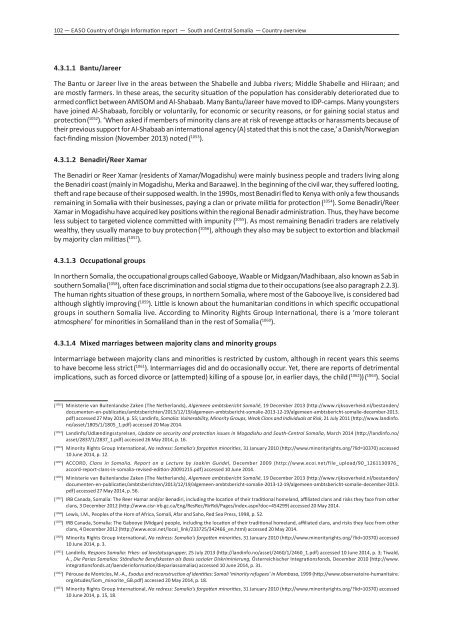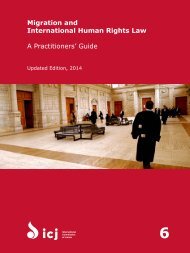Create successful ePaper yourself
Turn your PDF publications into a flip-book with our unique Google optimized e-Paper software.
102 — EASO Country of Origin Information report — South and Central <strong>Somalia</strong> — Country overview<br />
4.3.1.1 Bantu/Jareer<br />
The Bantu or Jareer live in the areas between the Shabelle and Jubba rivers; Middle Shabelle and Hiiraan; and<br />
are mostly farmers. In these areas, the security situation of the population has considerably deteriorated due to<br />
armed conflict between AMISOM and Al‐Shabaab. Many Bantu/Jareer have moved to IDP‐camps. Many youngsters<br />
have joined Al‐Shabaab, forcibly or voluntarily, for economic or security reasons, or for gaining social status and<br />
protection ( 1052 ). ‘When asked if members of minority clans are at risk of revenge attacks or harassments because of<br />
their previous support for Al‐Shabaab an international agency (A) stated that this is not the case,’ a Danish/Norwegian<br />
fact‐finding mission (November 2013) noted ( 1053 ).<br />
4.3.1.2 Benadiri/Reer Xamar<br />
The Benadiri or Reer Xamar (residents of Xamar/Mogadishu) were mainly business people and traders living along<br />
the Benadiri coast (mainly in Mogadishu, Merka and Baraawe). In the beginning of the civil war, they suffered looting,<br />
theft and rape because of their supposed wealth. In the 1990s, most Benadiri fled to Kenya with only a few thousands<br />
remaining in <strong>Somalia</strong> with their businesses, paying a clan or private militia for protection ( 1054 ). Some Benadiri/Reer<br />
Xamar in Mogadishu have acquired key positions within the regional Benadir administration. Thus, they have become<br />
less subject to targeted violence committed with impunity ( 1055 ). As most remaining Benadiri traders are relatively<br />
wealthy, they usually manage to buy protection ( 1056 ), although they also may be subject to extortion and blackmail<br />
by majority clan militias ( 1057 ).<br />
4.3.1.3 Occupational groups<br />
In northern <strong>Somalia</strong>, the occupational groups called Gabooye, Waable or Midgaan/Madhibaan, also known as Sab in<br />
southern <strong>Somalia</strong> ( 1058 ), often face discrimination and social stigma due to their occupations (see also paragraph 2.2.3).<br />
The human rights situation of these groups, in northern <strong>Somalia</strong>, where most of the Gabooye live, is considered bad<br />
although slightly improving ( 1059 ). Little is known about the humanitarian conditions in which specific occupational<br />
groups in southern <strong>Somalia</strong> live. According to Minority Rights Group International, there is a ‘more tolerant<br />
atmosphere’ for minorities in Somaliland than in the rest of <strong>Somalia</strong> ( 1060 ).<br />
4.3.1.4 Mixed marriages between majority clans and minority groups<br />
Intermarriage between majority clans and minorities is restricted by custom, although in recent years this seems<br />
to have become less strict ( 1061 ). Intermarriages did and do occasionally occur. Yet, there are reports of detrimental<br />
implications, such as forced divorce or (attempted) killing of a spouse (or, in earlier days, the child ( 1062 )) ( 1063 ). Social<br />
( 1052 ) Ministerie van Buitenlandse Zaken (The Netherlands), Algemeen ambtsbericht Somalië, 19 December 2013 (http://www.rijksoverheid.nl/bestanden/<br />
documenten‐en‐publicaties/ambtsberichten/2013/12/19/algemeen‐ambtsbericht‐somalie-2013-12-19/algemeen‐ambtsbericht‐somalie‐december-2013.<br />
pdf) accessed 27 May 2014, p. 55; Landinfo, <strong>Somalia</strong>: Vulnerability, Minority Groups, Weak Clans and Individuals at Risk, 21 July 2011 (http://www.landinfo.<br />
no/asset/1805/1/1805_1.pdf) accessed 20 May 2014.<br />
( 1053 ) Landinfo/Udlændingsstyrelsen, Update on security and protection issues in Mogadishu and South‐Central <strong>Somalia</strong>, March 2014 (http://landinfo.no/<br />
asset/2837/1/2837_1.pdf) accessed 26 May 2014, p. 16.<br />
( 1054 ) Minority Rights Group International, No redress: <strong>Somalia</strong>’s forgotten minorities, 31 January 2010 (http://www.minorityrights.org/lid=10370) accessed<br />
10 June 2014, p. 12.<br />
( 1055 ) ACCORD, Clans in <strong>Somalia</strong>. <strong>Report</strong> on a Lecture by Joakim Gundel, December 2009 (http://www.ecoi.net/file_upload/90_1261130976_<br />
accord‐report‐clans‐in‐somalia‐revised‐edition-20091215.pdf) accessed 10 June 2014.<br />
( 1056 ) Ministerie van Buitenlandse Zaken (The Netherlands), Algemeen ambtsbericht Somalië, 19 December 2013 (http://www.rijksoverheid.nl/bestanden/<br />
documenten‐en‐publicaties/ambtsberichten/2013/12/19/algemeen‐ambtsbericht‐somalie-2013-12-19/algemeen‐ambtsbericht‐somalie‐december-2013.<br />
pdf) accessed 27 May 2014, p. 56.<br />
( 1057 ) IRB Canada, <strong>Somalia</strong>: The Reer Hamar and/or Benadiri, including the location of their traditional homeland, affiliated clans and risks they face from other<br />
clans, 3 December 2012 (http://www.cisr‐irb.gc.ca/Eng/ResRec/RirRdi/Pages/index.aspxdoc=454299) accessed 20 May 2014.<br />
( 1058 ) Lewis, I.M., Peoples of the Horn of Africa, Somali, Afar and Saho, Red Sea Press, 1998, p. 52.<br />
( 1059 ) IRB Canada, <strong>Somalia</strong>: The Gabooye (Midgan) people, including the location of their traditional homeland, affiliated clans, and risks they face from other<br />
clans, 4 December 2012 (http://www.ecoi.net/local_link/233725/342466_en.html) accessed 20 May 2014.<br />
( 1060 ) Minority Rights Group International, No redress: <strong>Somalia</strong>’s forgotten minorities, 31 January 2010 (http://www.minorityrights.org/lid=10370) accessed<br />
10 June 2014, p. 3.<br />
( 1061 ) Landinfo, Respons <strong>Somalia</strong>: Yrkes- od lavstatusgrupper, 25 July 2013 (http://landinfo.no/asset/2460/1/2460_1.pdf) accessed 10 June 2014, p. 3; Tiwald,<br />
A., Die Parias <strong>Somalia</strong>s: Ständische Berufskasten als Basis sozialer Diskriminierung, Österreichischer Integrationsfonds, December 2010 (http://www.<br />
integrationsfonds.at/laenderinformation/diepariassomalias) accessed 10 June 2014, p. 31.<br />
( 1062 ) Pérouse de Montclos, M.-A., Exodus and reconstruction of identities: Somali ‘minority refugees’ in Mombasa, 1999 (http://www.observatoire‐humanitaire.<br />
org/etudes/Som_minorite_GB.pdf) accessed 20 May 2014, p. 18.<br />
( 1063 ) Minority Rights Group International, No redress: <strong>Somalia</strong>’s forgotten minorities, 31 January 2010 (http://www.minorityrights.org/lid=10370) accessed<br />
10 June 2014, p. 15, 18.



